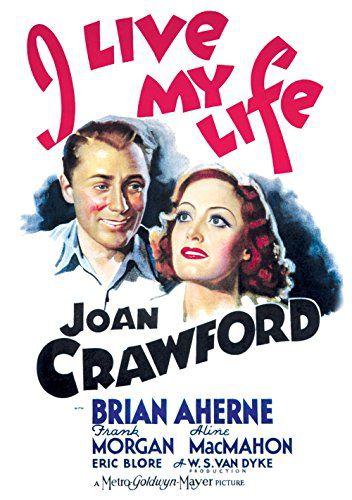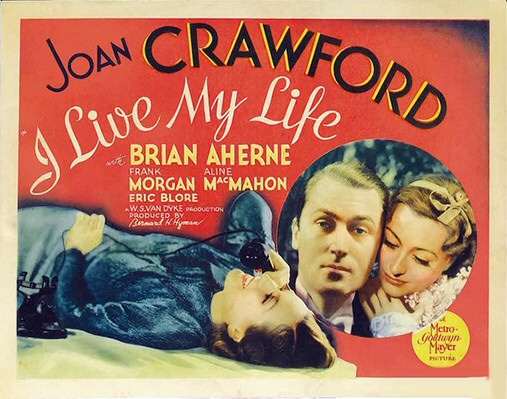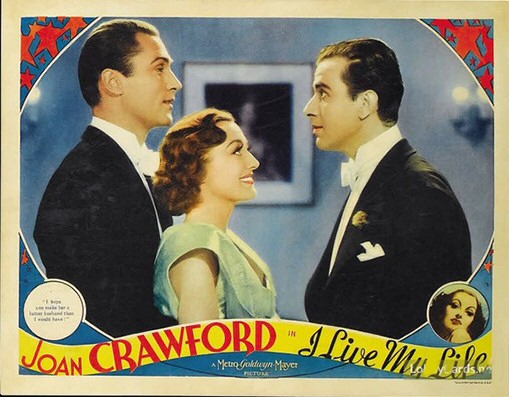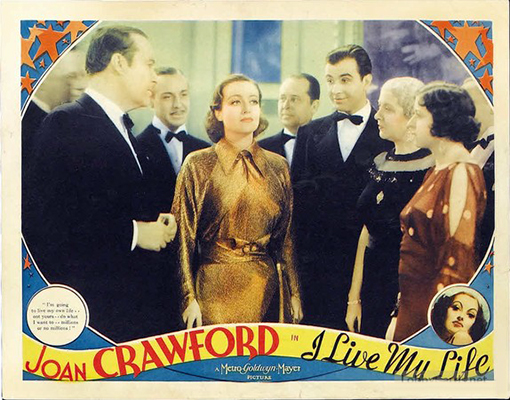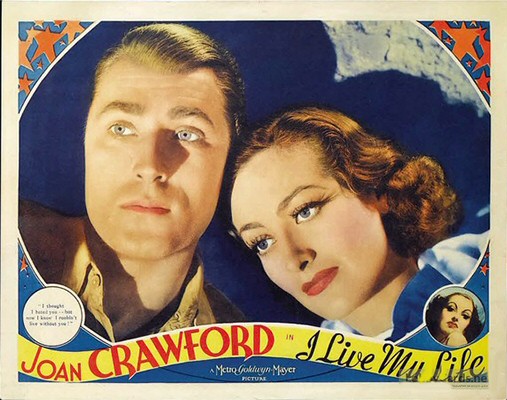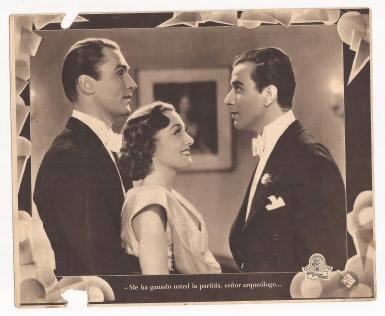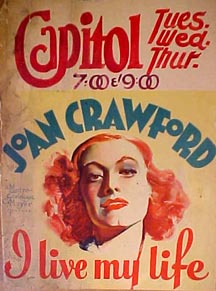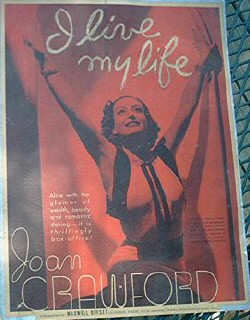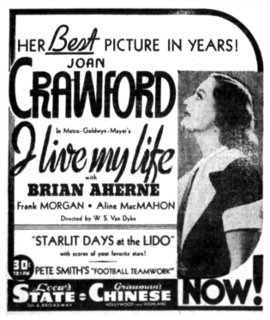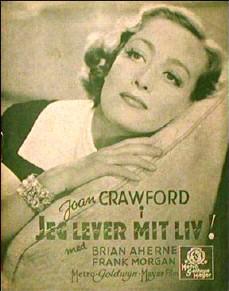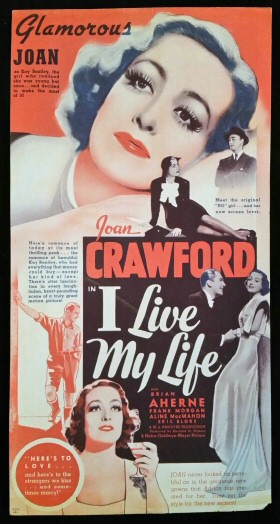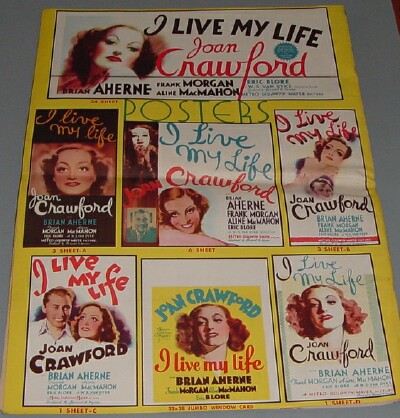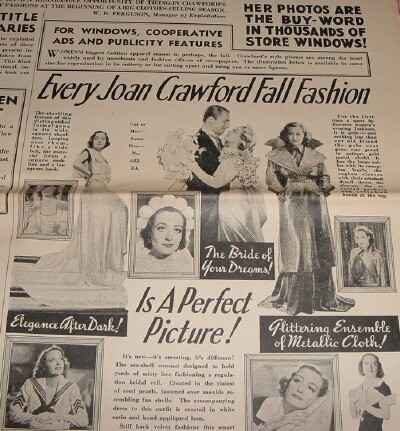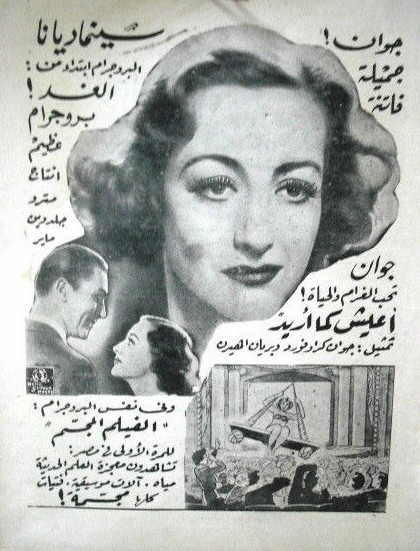 Tom C. (July 2023) Tom C. (July 2023)
Rating:    of 5 of 5
I was worried before watching I Live My Life (1935), given the similarity of its title to Today We Live (1933), which I did not enjoy. My fears were quickly allayed.
Brian
Aherne does a nice job as the nerdy archaeologist, Terry, who falls for Joan's
character, Kay. He's not overly impressed with Joan's vapid high-society friends and isn't shy about letting her know. (A
side-note: Aherne once again co-starred with Joan as the
grabby Fred Shalimar in The Best of Everything (1959) two-plus decades later.)
I
Live My Life (ILML) shows off Joan's skill in light,
screwball comedy. Her "catty corner" speech is a highlight. Likewise, the "Joan on
a donkey" scene is funny. She may treat Terry callously at times, but
you feel there is a good person beneath the Adrian-adorned exterior.
Speaking
of Adrian, I think this may be one of his better efforts in a Joan pic.
Many of the outfits that Joan/Kay wears show her off to good effect
without being over the top, with perhaps the exception of one silver
costume that looks like it could have been worn by a space alien.
A plus for I Live My Life is the fabulous supporting cast. Those with notable places in the Joan-iverse include:
- • John George: Alonzo's sidekick in The Unknown (1927).
- • Sterling Holloway: Appeared in Dancing Lady
(1933).
- • Jessie Ralph: Kudos to the cantankerous old lady who controls the purse strings. Ralph also
appeared in the 1937 Joan film The Last of Mrs. Cheyney, and had a very distinguished acting career (https://youtu.be/ZCJSJIR9AQS), most indelibly as crochety Aunt Katherine in After the Thin Man (1936). I wish they had used her more in ILML.
- • Arthur Treacher: Of fish & chips fame.
Playing, what else, a butler, just as in Forsaking All Others (1934).
- • Henry Kolker: Appeared in several Joan films---most notably 1925's Sally, Irene and Mary---and has a bit part here.
- • Aline
McMahon: I don't think she appeared in any other Joan film, but was
excellent as the grifter with a heart of gold in the 1932 classic One Way Passage, and is likewise very good in a limited role here.
About
the only character I didn't really get into was Frank Morgan as Kay's
dad. Morgan, in the movies I've seen him in, seems to play variations on
the same character. There are a couple of touching scenes, though, between him
and Joan.
A
minor gripe is that Terry and Kay's long-and-winding path from initial
meeting to the altar could have done with one less twist, shortening the
movie, but that's a minor quibble.
I
bought into the improbable romance after the meet-cute at the dig site
between the archaeologist and the socialite. If you do, too, I think
you'll enjoy ILML. Based on the box-office success,
I suspect Depression-weary audiences were happy to see a common lad tell off society folks
and marry a rich girl.
 Stephanie
Jones (March 2023) Stephanie
Jones (March 2023)
Rating:   - 1/2 of
5 - 1/2 of
5
Writer,
and later producer, Joseph Mankiewicz represents Joan at the first nadir
of her artistic career---he wrote this mediocre film and the dismal
Forsaking All Others (1934) and produced the relatively uninspired
Gorgeous
Hussy ('36), Bride Wore Red
('37), Mannequin ('38), Shining Hour ('38), and
Reunion in France ('42). No thanks also to director Van Dyke
for Forsaking and this run-of-the-mill film. (Though both
he and Mankiewicz partially redeemed themselves with the rather
fetching Love on the Run in '36.)
I
Live My Life is a generic attempt at witty social banter, combined
with the by-now outdated late-20s/early-30s Joan movie-theme
of "society snob meets working man/woman." Sometimes Joan's
been the worker; more often she's been the snob meeting the
working-man, as in this case. Here, Brian Aherne plays "Terry
O'Neil," an Irish archaeologist (who speaks with a perfect
British accent) with a hatred for the "soft" and the "class-conscious"
and the city-dwellers. Like Joan's Kay Bentley, who happens upon
O'Neil at a dig in Greece while her father's yacht is anchored off-shore.
(A side-note: As I understand it, archaeologists in the 1800s and
1900s were usually either very rich themselves or liberally funded
by the rich. So I don't know where O'Neil's self-righteousness comes
from.) Given O'Neil's distaste for the rich, Joan's Kay pretends
to be a mere secretary, with a fake name. After only a day together---and
O'Neil's recounting of the story of Pygmalion and Galatea (we're
supposed to think Joan is the malleable Galatea? Really?)---O'Neil
professes his love and desire to marry her; Kay then disappears
back to her yacht and sails home, dropping only the name of her
father's business firm (where she's allegedly only a secretary),
should he care to look her up next time he's in NYC...
He
does, alas, and many attempts at banter occur for the next hour.
Like (O'Neil to Kay): "Have
you ever been punched right in the nose?"
Followed by his pushing her down in her chair at least four times...
Not objecting for #MeToo reasons but rather because of the
greater artistic sin: His dumb manhandling is too-heavy and gratuitous
rather than "witty" or contributing to character development
in this allegedly "light comedy."
An
extremely weak side-plot (again, borrowed from the late '20s and
early '30s) is the fact that Kay's rich grandma---Mrs. Gage---might
not approve, and might cut off Kay's $3 million "marriage settlement"
if Kay doesn't marry the wimpy pre-approved "Gene" rather
than O'Neil. Apparently, Kay's father (the, as usual, mumbledy,
befuddled Frank Morgan) might also not be able to pay
off a large debt if his daughter doesn't marry Gene. (Huh? I'm not
sure what Gene had to do with the father's debt.) After an hour-long lead-up
to this confrontation with the supposedly formidable Mrs. Gage (too-briefly
played by Jessie Ralph, later to appear to better effect in
1937's Mrs. Cheyney, along with Morgan), Mrs. Gage immediately
gives O'Neil a job in the firm upon finding out that his family
were pirates and swindlers! Oh, but O'Neil's still not happy, and
he and Kay still argue, right up until their wedding ceremony...
Joan
looks pretty in her arguments (even with meaningless close-ups and
meaningless smashings of flowers and lamps), and Aherne's a relatively
strong actor and presence (weaker than Gable, stronger than Montgomery,
and much stronger than Tone). But the script is terribly weak and
the constant "I love you" / "I don't love you"
ludicrous plot twists without reason soon get very dull. As
does the by-now tedium of Frank Morgan's mutterings. I'm also especially
disappointed that there wasn't an actual confrontation with Jessie
Ralph---this alleged terror was talked about throughout the whole
film but only appeared briefly at the end and turned out to be a
complete non-entity.
One
Joan line that stood out amidst this tedium: It's
my life, and I'll live it the way I want: Upside-down, kitty-cornered,
or slidin' down a pole!
 Michael Lia (November 2009) Michael Lia (November 2009)
Rating:
   of 5 of 5
When I want something with flair and an easy blend of sophistication, I
choose this harmless and actually well-done comedy. A change of pace for me, a
change of pace for Miss Crawford. I like to see a young Joan bouncing around on
the screen. I am very glad she has given me so many choices for my movie moods.
When I want her young, vivacious, and candid, I seek out a movie like this.
Because of the expert and often effortless direction of
W.S. VanDyke,
Miss Crawford’s comedy performance is as good as the French lady and as
carefree as Irene Dunne or the other comedic gals. It is a shame that comedic
performances like these are forgotten or never drawn upon and reexamined to
consider Miss Crawford’s wide range. It’s wide and she gives us a
glowing portrayal. Remember, this is entertainment!
Mr. Brian Aherne and Miss Crawford share that old love/hate romance, with
the right amount of home-spun feeling and chemistry. Mr. Aherne is a swarthy
chap here. (I would go dig some holes with him!) He finally breaks Miss Crawford
down, as well as some of the tedious moments of the script. They then take us on a free-flying journey, or as far as the censors will let them.
The number one reason I am satisfied with this film is because of one
person: Mr. Frank Morgan, teamed here for the first time with Miss
Crawford, is absolutely the best in the business and the best thing in the
movie.
Reason number two would be Eric Blore:
He steals scenes in a good way (by adding to them); he just has to roll his eyes or give a look and he is
fabulous. His voice is aligned with the English-butler school of comedy and
drama. Only he can say those
lines. I can
watch him anytime; he has bits of side comedy with another wonderful man andbutler, Arthur Treacher. Expertly
funny together.
The supporting players in the cast are too numerous to talk about (but
I will anyway; they deserve a mention). My grand old lady Jessie Ralph shouts up
a storm and is usually complaining. She has fun in anything she plays in. (She
has a soft heart and will make you cry in Camille.) Aline MacMahon is a face I always love to see. She is a strong
comedian and can throw out a comedic line like you throw out the trash. Edward Brophy:
Look for him palling around with the “Thin Man”
--
a great wisecracker, and he snarls out his lines like he’s in a dumpster. Etienne Girardot has been around and shows up in these early films, usually
as an old professor or country doctor. Lionel Stander,
identified by his raspy voice, is still a novice and only
gets the back of his head in camera range during a card-game scene, but in two
years he gets the role of “Libby” in 1937's A Star Is Born--
then you will never forget him. My thanks also to MGM for having these folks around: Sterling Holloway;
Hale
Hamilton; and Hedda Hopper, claiming her piece of Hollywood
history (be nice okay!?).
With the usual production values of MGM, and Mr. Mankiewicz getting
acquainted with Miss Crawford and getting used to “one shot woody,”
he puts together a fun show. Enjoy yourself.
 Jon
Denson (March 2006) Jon
Denson (March 2006) Rating:
   of 5 of 5
Joan was going through a lapse of mediocrity when she made "I Live My
Life." Also having made the unspectacular but marginally entertaining
"No More Ladies," this film was a step in the same direction.
The film does have numerous assets, however, including adequate
performances by the leads Joan Crawford and Brian Aherne. Joan, in
particular, is very appealing throughout, if not always up to the
comedic challenges. She gives it a worthy effort, though, as always.
Aherne seems less comfortable in a screwball comedy, almost serious at times, but overall his attractiveness wins.
The rest of the cast is glittering as well, with supporting roles
played exceedingly well by the likes of Jessie Ralph and Frank Morgan.
MGM went all out with the production values here and the result is a
glossiness typical of the studio. The early scenes are the most
effective, chronicling the romantic adventures of Joan's character on an island.
The plot is typical fluff, little worth mentioning except the
intelligent and spirited romance in some of the early scenes. One of
these scenes occurs when Aherne travels to New York to meet up with
Crawford and she explains to him "she can't change the way she is," which in
turn he replies in terms of her weakness for not trying to change. It is an intelligent scene, but sadly the rest of the film soon becomes
overwhelmed by the forced comedic situations and the miscasting of the
lead players.
The film does work well as a Crawford star vehicle, however. She is in
top form and as youthfully glamorous as ever. Crawford's appeal alone
can not save the film from the weight of too many clichés and the
overall tiredness of the plot elements. We've seen it all before. It
should be noted that, although the film as a whole is not entirely effective, the first half is remarkably good, with some cute moments which point to the overall potential of the film.
|
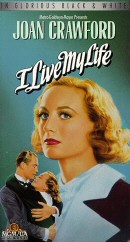
 MGM. 85 minutes.
US release: 10/4/35.
MGM. 85 minutes.
US release: 10/4/35. Tom C. (July 2023)
Tom C. (July 2023)
 Michael Lia
Michael Lia 

